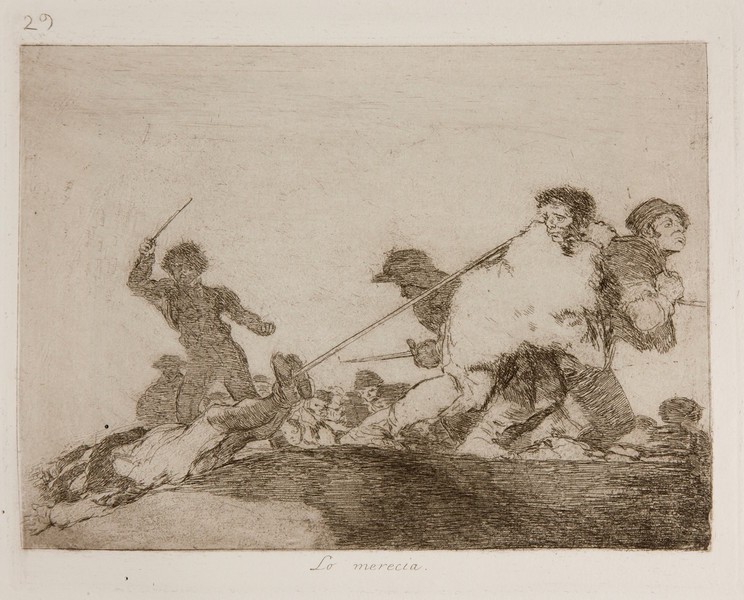- Cronología
- Ca. 1810 - 1812
- Dimensiones
- 180 x 220 mm
- Técnica y soporte
- Etching, burin, drypoint and burnisher
- Reconocimiento de la autoría de Goya
- Undisputed work
- Ficha: realización/revisión
- 06 Dec 2010 / 16 Jun 2025
- Inventario
- 225
SeeSad presentiments of what must come to pass.
The title was handwritten on the print by Goya in the first and only series that is known to have been printed at the time the works were created, which the artist gave to his friend Agustín Ceán Bermúdez. Therefore, the title was etched into the plate at a later date and left unchanged as of the first edition of the Disasters of War printed by the San Fernando Royal Academy of Fine Arts in Madrid in 1863, after the printing of the series in the possession of Ceán Bermúdez.
There is a surviving preparatory drawing for this print which is housed in the Prado Museum.
In He Deserved It two men pull a rope attached to a body - possibly a corpse - which is naked from the waist down. Behind them is a fervent crowd led by a man brandishing a rod in his hand.
Goya depicts the faces of the two men pulling the rope in great detail. One of them looks with compassion at the body they are dragging behind them, while the other concentrates on his task with closed eyes, perhaps in an attempt to avoid thinking about the odious task they are carrying out.
This print may continue the story depicted in the previous print in the series, nº 28, Mob (Populacho).If this is the case, the scene continues here with the dragging of the body that was being beaten in front of the mob in the previous print, a crowd that takes pleasure in the macabre spectacle.
Goya composed the scene based on a diagonal line formed by the two men, the rope, and the body. The figures in the background seem to be given a secondary importance: the one closest to the body is shown against the light, making it impossible to see their face. The faces of those following the body in a morbid procession are sketched in a perfunctory manner, giving them the appearance of masks.
The way Goya has represented the figure in the foreground pulling the rope - the figure that looks back at what may be a corpse with a look of anguish - is striking. His body is totally white, a device that could be interpreted as being employed by the painter to highlight the figure's facial expression. Perhaps this figure, wracked by doubt, tries to justify their action by convincing himself that their victim "deserved it".
While it is true to say that this kind of scene must have been very common during the war, in some cases it has been suggested that this image may be linked to the gathering of the bodies of the French soldiers who fell in Zaragoza on 4 August 1808 and were dragged through the city.
The plate is stored in the National Chalcography (cat. 280)
-
Francisco de GoyaMuseo d'Arte ModernaLugano1996exhibition celebrated from September 22nd to November 17th.cat. 29
-
Francisco Goya. Sein leben im spiegel der graphik. Fuendetodos 1746-1828 Bordeaux. 1746-1996Galerie KornfeldBern1996from November 21st 1996 to January 1997cat. 152
-
Francisco Goya. Capricci, follie e disastri della guerraSan Donato Milanese2000Opere grafiche della Fondazione Antonio Mazzottacat. 109
-
Goya. Opera graficaPinacoteca del Castello di San GiorgioLegnano2006exhibition celebrated from December 16th 2006 to April 1st 2007p. 65
-
Goya en tiempos de guerraMuseo Nacional del PradoMadrid2008consultant editor Manuela B. Mena Marqués, from April 14th to July 13th 2008cat. 101
-
Goya et la modernitéPinacothèque de ParisParís2013from October 11st 2013 to March 16th 2014cat.68
-
Goya, grabadorMadridBlass S.A.1918cat. 131
-
Los Desastres de la guerra. Etched by Francisco de Goya y LucientesRoxburghe Club1933p. 4
-
Goya engravings and lithographs, vol. I y II.OxfordBruno Cassirer1964cat. 149
-
Vie et ouvre de Francisco de GoyaParísOffice du livre1970cat. 1042
-
Goya. Arte e condizione umanaNaplesLiguori editore1990lam. 201
-
Catálogo de las estampas de Goya en la Biblioteca NacionalMadridMinisterio de Educación y Cultura, Biblioteca Nacional1996cat. 231
-
ParísPinacoteca de París2013p. 134
-
Goya. In the Norton Simon MuseumPasadenaNorton Simon Museum2016pp. 114-151

